Multi-Scale Mechanisms for Permeability Evolution in Remolded Fault Gouge: From Mineral-Particle Migration to Pore Structure
Abstract
1. Introduction
| Methods | Traditional Compaction Method | Binder Simulation Method | Our Method |
|---|---|---|---|
| Definition | External mechanical energy to simulate in situ compaction | External binders to simulate the strength of the rock mass | Mineral self-cementation combined with directional compaction |
| Advantages | Easy operation | High bonding strength | Restoration of stress and bonding state |
| Shortcomings | a. Anisotropic irreversibility b. Absence of geological processes c. Mechanical crushing alters particle size distribution | a. Differences in cementation b. Bonding distribution non-uniformity | a. Complex sample preparation process |
| References | Ma [22,24]; Gui [23]; Huang [25] | Yu [18,20]; Ma [19] | / |
2. Materials and Methods
2.1. Sample Geology
2.2. Test Equipment
- (1)
- Remolded sample preparation: Based on existing literature and site geological data, and considering the weak cementation of fault materials, a mineral self-cementation combined with directional compaction method was employed. This approach simulates diagenetic conditions to reproduce natural structural and cementation characteristics, ensuring geological representativeness of the remolded samples.
- (2)
- Permeability testing: Comparative permeability tests between in situ and remolded samples were conducted to systematically analyze differences in permeability coefficient and critical hydraulic gradient. These tests revealed how structural differences control hydraulic conductivity through macroscopic flow behavior.
- (3)
- Mechanical property testing: Uniaxial compression and direct shear tests were conducted on both remolded and in situ samples. These tests yielded strength parameters (cohesion and internal friction angle) and deformation parameters (elastic modulus) for comparative analysis of mechanical behavior.
- (4)
- Microstructural characterization: X-ray diffraction (XRD) and scanning electron microscopy with energy-dispersive spectroscopy (SEM-EDS) were employed to identify mineral composition, cementation characteristics, and structural features through elemental distribution and micromorphology analysis. These analyses established correlations between microstructure and macroscopic mechanical response, providing mechanistic insights into fault zone behavior.
- (5)
- Pore structure characterization: Nuclear magnetic resonance (NMR) was employed to quantitatively characterize pore distribution, pore size distribution, and connectivity in both in situ and remolded samples. This analysis revealed pore-scale structural mechanisms controlling differences in hydraulic and mechanical properties.
2.3. Remolded Samples
- (1)
- Sample preparation: To meet testing apparatus requirements, remolded samples with dimensions of ø100 mm × h200 mm were prepared. Following standards GB/T 50123-2019 and ASTM D7012-14 [30,31], the maximum particle size should not exceed one-fifth of the sample diameter. Therefore, the maximum particle size used was 20 mm. The total mass for each grain size fraction was calculated based on the in situ grain size distribution and target dry density. The material was divided into five layers, and the required mass mi for each grain size fraction within each layer was determined.
- (2)
- Water addition, mixing, and manual pre-compaction: The inner mold walls were lined with 0.2 mm PVC film to reduce boundary friction. Material was filled in layers to controlled heights, lightly compacted manually with roughened interfaces to enhance interlocking, ensuring uniform distribution in each 45 mm layer.
- (3)
- Mechanical compaction: The pre-compacted sample (height ≈ 225 mm) was placed on the compaction platform. Displacement-controlled compaction was then applied gradually. Compaction was ceased when the mold contacted the fixed height stop block (200 mm).
- (4)
- Demolding and air-drying: Compacted samples were allowed to rest in situ for 5–10 h to minimize elastic rebound. Samples were then removed and placed on an automated air-drying platform. Sample mass was recorded daily until mass stabilization was achieved.
- (5)
- Self-cementation conditions: During the sample preparation, only distilled water was used to mix and stir the materials, and no external cementing agents were added. After mixing, the samples were compacted into shape and then subjected to a 7-day controlled self-cementation process. This process was conducted in a constant-temperature environment (25 ± 2 °C), and the relative humidity was gradually reduced from 95% to 50% through a programmed procedure, simulating natural diagenetic conditions.
3. Experimental Results
3.1. Mechanical Properties of In Situ Samples
3.2. Mechanical Properties of Remolded Samples
3.3. Evolution of In Situ Permeability Characteristics
3.3.1. In Situ Water Pressure Tests
3.3.2. In Situ Permeation Test
3.4. Evolution of Remolded Sample’s Permeability Characteristics
3.4.1. Laboratory Permeation Tests
3.4.2. Seepage–Stress Coupling Test
4. Discussions
4.1. Permeability Differences Between In Situ and Remolded Samples
4.2. Mechanical Property Alterations
4.3. Mineralogical Evolution and Elemental Redistribution
4.3.1. Disintegration Characteristics
4.3.2. Mineral and Elemental Changes
4.4. Remodeling of Pore Structure and Size Distribution
5. Conclusions
- (1)
- The reduction in permeability of remolded samples is primarily due to the degradation of pore connectivity and migration of mineral particles. SEM-EDS analysis revealed a significant leaching of cementing agents (K+, Ca2+ ions), while XRD confirmed chlorite dissolution as the dominant mechanism responsible for permeability decay.
- (2)
- The multi-scale pore structure plays a crucial role in controlling permeability. Remolded samples exhibit a more uniform pore distribution, with tiny pores and reduced connectivity compared to in situ samples, leading to a substantial decrease in permeability.
- (3)
- In terms of mechanical properties, remolded samples show enhanced cohesion and internal friction angle compared to intact samples, mainly due to uniform particle distribution and densification during remolding. However, this enhancement can distort mechanical behavior, leading to an overestimation of shear strength in laboratory tests relative to in situ conditions.
- (4)
- Conventional laboratory tests tend to underestimate the in situ permeability and overestimate shear strength of fault zones, primarily due to the disruption of natural structural features and cementation in remolded samples.
Author Contributions
Funding
Data Availability Statement
Conflicts of Interest
References
- Li, S.-C.; Xu, Z.-H.; Huang, X.; Lin, P.; Zhao, X.-C.; Zhang, Q.-S.; Yang, L.; Zhang, X.; Sun, H.-F.; Pan, D.-D. Classification, geological identification, hazard mode and typical case studies of hazard-causing structures for water and mud inrush in tunnels. Chin. J. Rock Mech. Eng. 2018, 37, 1041–1069. [Google Scholar] [CrossRef]
- Liu, S.-H.; Xu, S.-Y.; Zhou, B. In situ seepage testing method for fractured zones of rock mass. Q. J. Eng. Geol. Hydrogeol. 2021, 54, qjegh2020-050. [Google Scholar] [CrossRef]
- Zhao, Y.-S.; Deng, W.-J.; Li, L.-D.; Gao, H.-M. In-situ seepage deformation testing method for shear zones. In Proceedings of the 2021 7th International Conference on Hydraulic and Civil Engineering & Smart Water Conservancy and Intelligent Disaster Reduction Forum (ICHCE & SWIDR), Nanjing, China, 6–8 November 2021; IEEE: New York, NY, USA, 2021; pp. 1307–1313. [Google Scholar] [CrossRef]
- Bense, V.-F.; Gleeson, T.; Loveless, S.-E.; Bour, O.; Scibek, J. Fault zone hydrogeology. Earth-Sci. Rev. 2013, 127, 171–192. [Google Scholar] [CrossRef]
- Wang, S.-Z.; Wu, Q.-Q.; Song, M.-Y.; Yu, H.-Z.; Zhang, G.-L. Quantitative evaluation of the transportation of fault zone and its controlling effect on hydrocarbon migration and accumulation: Case study of Hala’alat Mountain tectonic belt in the north margin of Junggar Basin. Nat. Gas Geosci. 2018, 29, 1559–1567. [Google Scholar] [CrossRef]
- Zhang, R.; Guo, Y.; Xiao, S.-H.; Liu, Y.; Li, X.-S. Microscopic study on permeability test of core in fracture zone. J. Eng. Geol. 2019, 27, 497–504. [Google Scholar]
- Chenal, S.-K. Estimation of Permeability, Porosity, and Grain-Size Distributions Across the San Andreas Fault Zone in Northwest Coachella Valley, CA (Riverside County). Master’s Thesis, California State University, Northridge, CA, USA, 2014. [Google Scholar]
- Merico, A.; Iezzi, G.; Pace, B.; Ferranti, L.; Cremona, M.; Scafa, M.; Cavallo, A.; Colella, A.; Nazzari, M.; Scarlato, P. Grain size and grain size distribution of a lithified fault core in carbonates rocks using multi-scale image analysis: The example of the San Benedetto-Gioia dei Marsi fault (Central Italy). J. Struct. Geol. 2020, 134, 104017. [Google Scholar] [CrossRef]
- Suo, P.-S. Research on the Intrinsic Structure Feature and Characterization Means of Fault Zone. Master’s Thesis, Nanjing University, Nanjing, China, 2014. [Google Scholar]
- Pusch, R.; Schomburg, J. Impact of microstructure on the hydraulic conductivity of undisturbed and artificially prepared smectitic clay. Eng. Geol. 1999, 54, 167–172. [Google Scholar] [CrossRef]
- Zhai, J.-T.; Wang, J.-L.; Yang, J. Study on Transmissivity of Shattered Fault Zone Under Ground Pressure. Saf. Coal Mines 2012, 43, 37–40. [Google Scholar] [CrossRef]
- Xue, L.; Li, H.-B.; Brodsky, E.-E.; Xu, Z.-Q.; Kano, Y.; Wang, H.; Mori, J.-J.; Si, J.-L.; Pei, J.-L.; Zhang, W.; et al. Continuous permeability measurements record healing inside the Wenchuan earthquake fault zone. Science 2013, 340, 1555–1559. [Google Scholar] [CrossRef] [PubMed]
- Matsumoto, N.; Shigematsu, N. In-situ permeability of fault zones estimated by hydraulic tests and continuous groundwater-pressure observations. Earth Planets Space 2018, 70, 3–12. [Google Scholar] [CrossRef]
- Zeng, L.-L.; Hong, Z.-S.; Cai, Y.-Q.; Han, J. Change of hydraulic conductivity during compression of in-situ and remolded clays. Appl. Clay Sci. 2011, 51, 86–93. [Google Scholar] [CrossRef]
- Sun, D.-A.; Xu, Z.-L. Permeability of structural soft soils. Hydrogeol. Eng. Geol. 2012, 39, 36–41. [Google Scholar]
- Nam, S.; Gutierrez, M.; Diplas, P.; Petrie, J. Laboratory and in situ determination of hydraulic conductivity and their validity in transient seepage analysis. Water 2021, 13, 1131. [Google Scholar] [CrossRef]
- Chen, J.; Verberne, B.-A.; Niemeijer, A.-R. Flow-to-friction transition in simulated calcite gouge: Experiments and microphysical modelingssss. J. Geophys. Res. Solid Earth 2020, 125, e2020JB019970. [Google Scholar] [CrossRef]
- Yu, B.-Y.; Chen, Z.-Q.; Wu, Y.; Zhang, S.-B.; Yu, L.-L. Experimental study on the seepage characteristics of cemented broken mudstone. J. Min. Saf. Eng. 2015, 32, 853–858. [Google Scholar] [CrossRef]
- Ma, D.; Duan, H.-Y.; Zhang, J.-X.; Feng, X.-J.; Huang, Y.-L. Experimental investigation of creep-erosion coupling mechanical properties of water inrush hazards in fault fracture rock masses. Chin. J. Rock Mech. Eng. 2021, 40, 1751–1763. [Google Scholar] [CrossRef]
- Yu, B.-Y.; Chen, Z.-Q.; Wu, J.-Y.; Wang, L.-Z. Experimental study of non-Darcy flow seepage properties of cemented broken rocks with mass loss. J. China Univ. Min. Technol. 2017, 2, 321–327. [Google Scholar] [CrossRef]
- Yin, Y.; Cui, Z.-T.; Zhang, X.; Song, J.; Zhang, X.-Y.; Chen, Y.-Q.; Dou, Z. Effects of clay content on non-linear seepage behaviors in the sand–clay porous media based on low-field nuclear magnetic resonance. Water 2024, 16, 883. [Google Scholar] [CrossRef]
- Ma, D.; Li, Q.; Zhang, J.-X.; Liu, Y.; Hou, W.-T. Pore structure characterization and nonlinear seepage characteristics of rock mass in fault fracture zones. J. China Coal Soc. 2023, 48, 666–677. [Google Scholar] [CrossRef]
- Gui, H. Impacts of Different Material Compositions on the Permeability of Fractured Fault Zone in Coal Measures. Ph.D. Thesis, China University of Mining and Technology, Xuzhou, China, 2017. [Google Scholar]
- Ma, D.; Duan, H.-Y.; Li, X.-B.; Li, Z.-H.; Zhou, Z.-L.; Li, T.-B. Effects of seepage-induced erosion on nonlinear hydraulic properties of broken red sandstones. Tunn. Undergr. Space Technol. 2019, 91, 102993. [Google Scholar] [CrossRef]
- Huang, C.-F.; Zhang, S.-L.; Gao, Y.-T.; Wu, S.-C.; Zhou, Y.; Sun, H.; Wang, W.-Q.; Lu, Q.-Z. Influence of particle loss on the seepage characteristics of tuff in the fault fracture zone under triaxial stress. Chin. J. Eng. 2022, 44, 1134–1146. [Google Scholar] [CrossRef]
- Wang, L.-Z.; Chen, Z.-Q.; Kong, H.-L.; Shen, H.-D. Experimental study of impact of loading history on permeability characteristics of broken coal with different grain size gradations. Rock Soil Mech. 2013, 34, 1325–1330. [Google Scholar] [CrossRef]
- Wang, L.-Z.; Chen, Z.-Q.; Kong, H.-L.; Ni, X.-Y. An experimental study of the influence of seepage pressure and initial porosity on variable mass seepage for broken mudstone. J. Min. Saf. Eng. 2014, 31, 462–468. [Google Scholar] [CrossRef]
- Zhao, Y.; Zhou, H.; Feng, X.-T.; Shao, J.-F.; Jiang, Q.; Lu, J.-J.; Jiang, Y.-L.; Huang, K. Residual shear behaviour and particle crushing of an infilled joint soil under high stress. Rock Soil Mech. 2012, 33, 3299–3305. [Google Scholar] [CrossRef]
- Zeng, L.-L.; Cai, C. Effect of soil structure on the hydraulic conductivity behaviour of clays. J. Fujian Univ. Technol. 2012, 10, 230–234. [Google Scholar]
- GB/T 50123-2019; Standard for Geotechnical Testing Method. Ministry of Housing and Urban-Rural Development of the People’s Republic of China (MOHURD); China Planning Press: Beijing, China, 2019.
- ASTM D7012-14; Standard Test Methods for Compressive Strength and Elastic Moduli of Intact Rock Core Specimens under Varying States of Stress and Temperatures. ASTM International: West Conshohocken, PA, USA, 2014.
- GB/T 50266-2013; Standard for Test Methods of Engineering Rock Masses. Ministry of Housing and Urban-Rural Development of the People’s Republic of China (MOHURD); China Planning Press: Beijing, China, 2013.
- DL/T 5368-2007; Specification for Rock Tests in Water Conservancy and Hydroelectric Engineering. National Development and Reform Commission of the People’s Republic of China (NDRC); China Electric Power Press: Beijing, China, 2007.
- SL 31-2003; Code for Water Pressure Test in Borehole for Water Resources and Hydropower Engineering. Ministry of Water Resources of the People’s Republic of China (MWR); China Water & Power Press: Beijing, China, 2003.
- Louis, C.-L. Introduction à l’hydraulique des roches. BULL BRGM, III. 1974. Available online: https://trid.trb.org/View/1069005 (accessed on 21 November 2022).
- GB 50487-2008; Code for Geological Investigation of Hydraulic and Hydroelectric Engineering. Ministry of Housing and Urban-Rural Development of the People’s Republic of China (MOHURD); China Planning Press: Beijing, China, 2008.
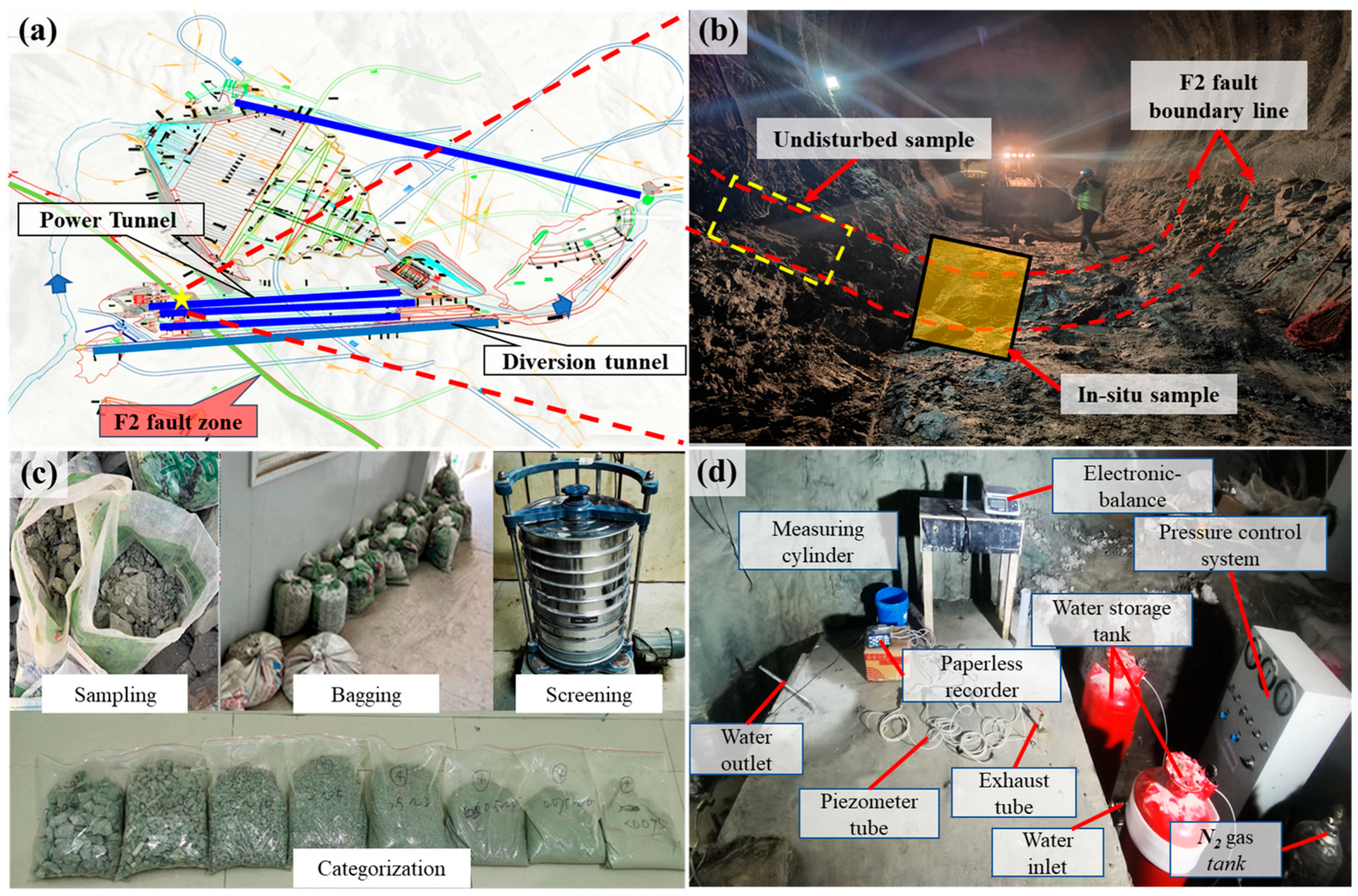
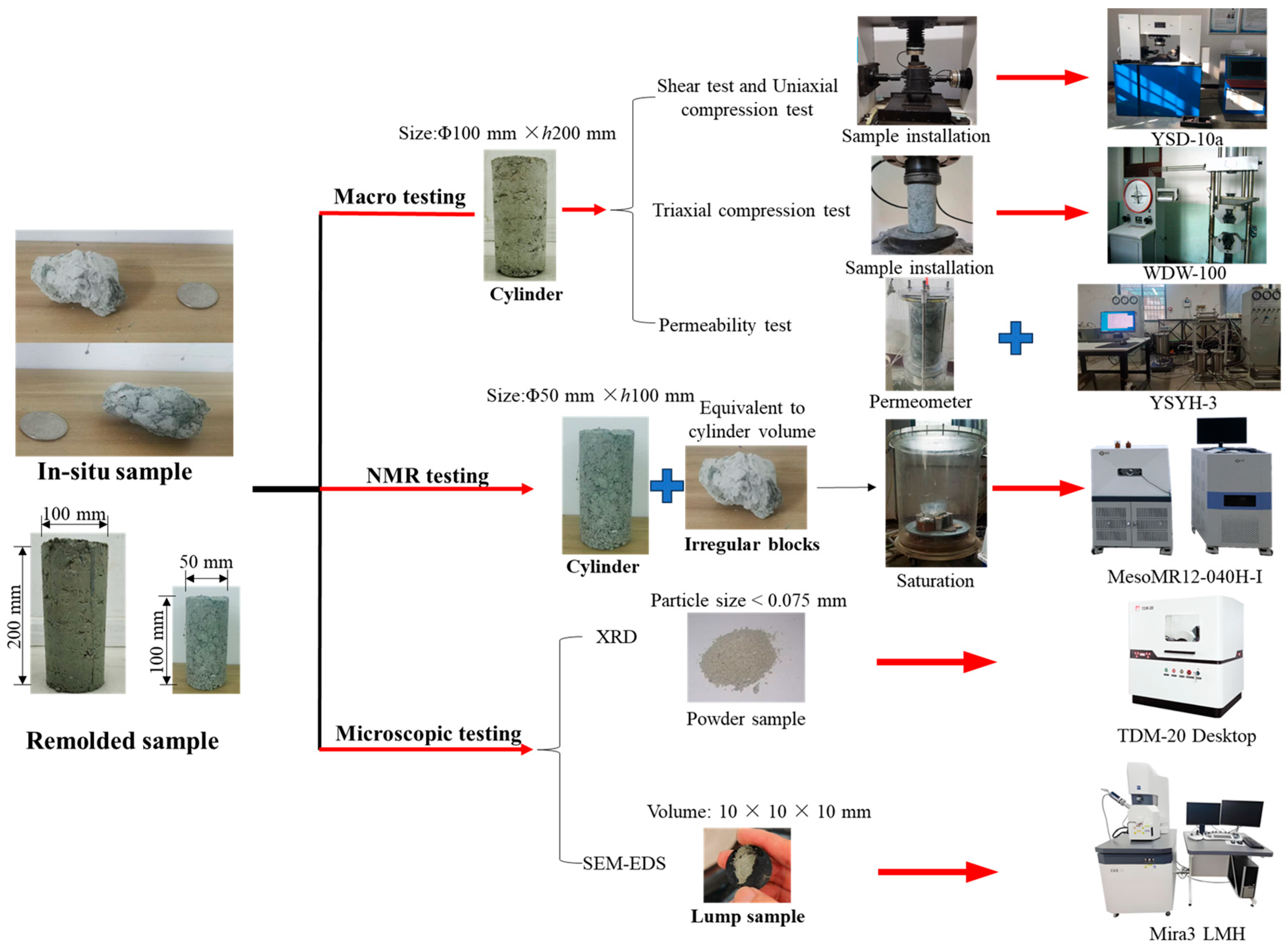

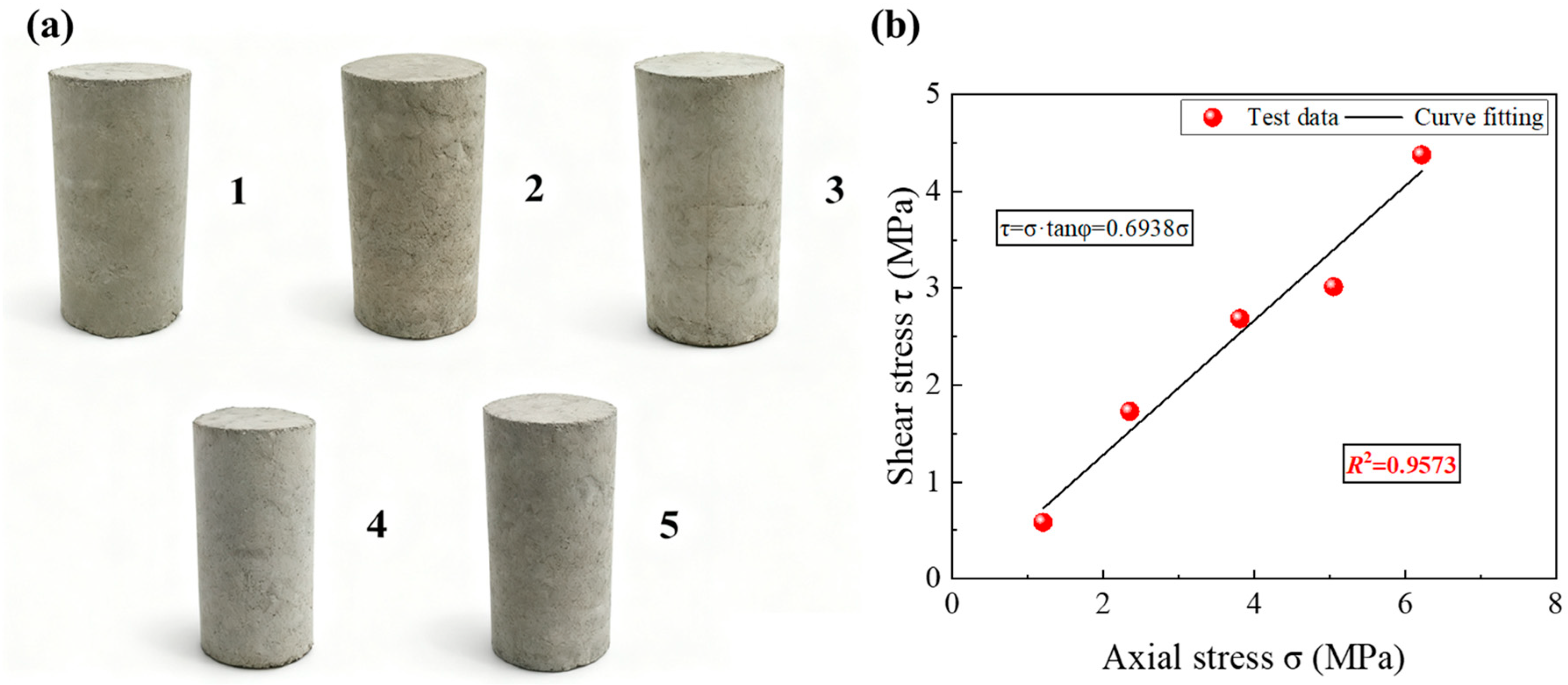

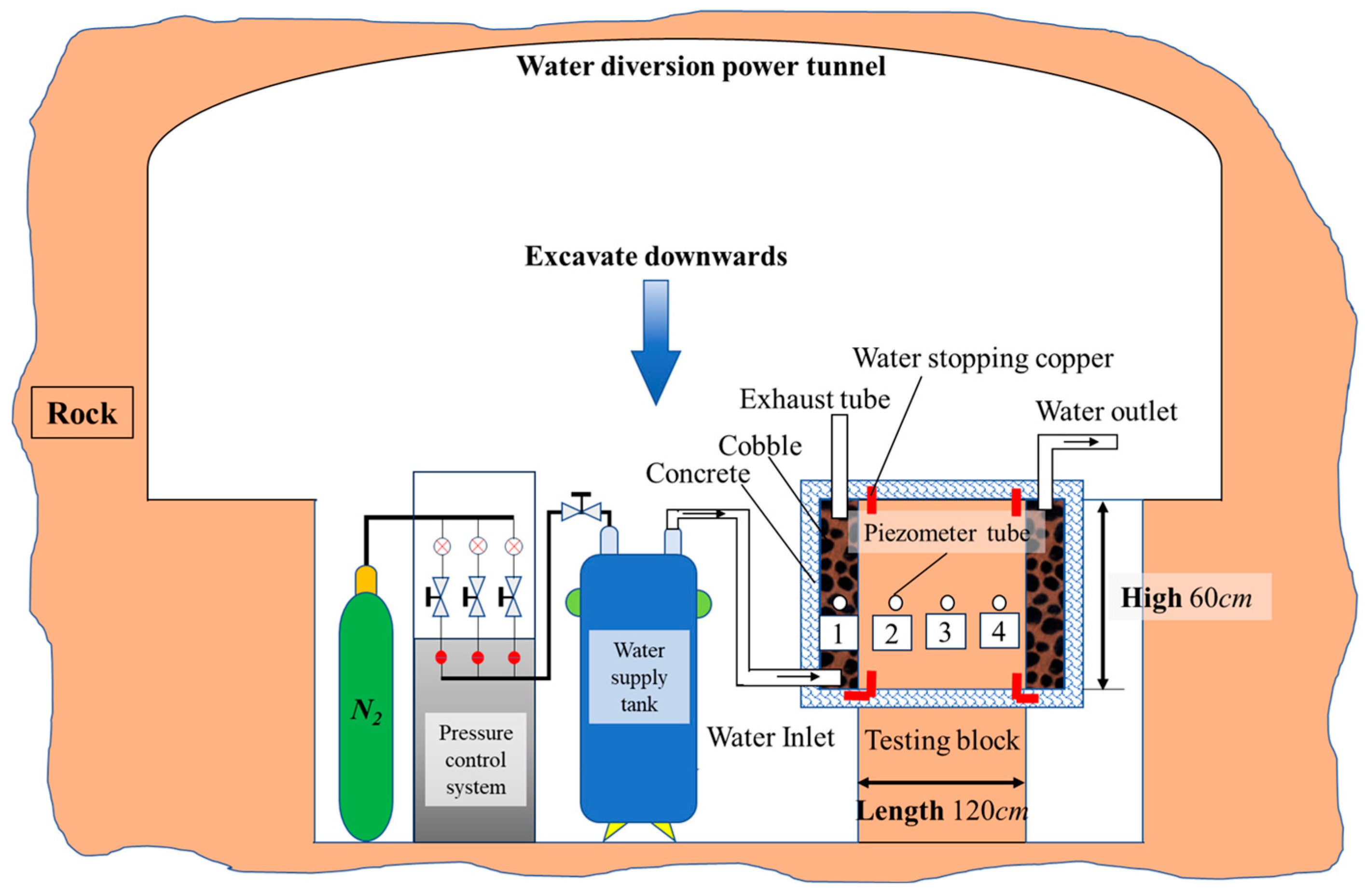
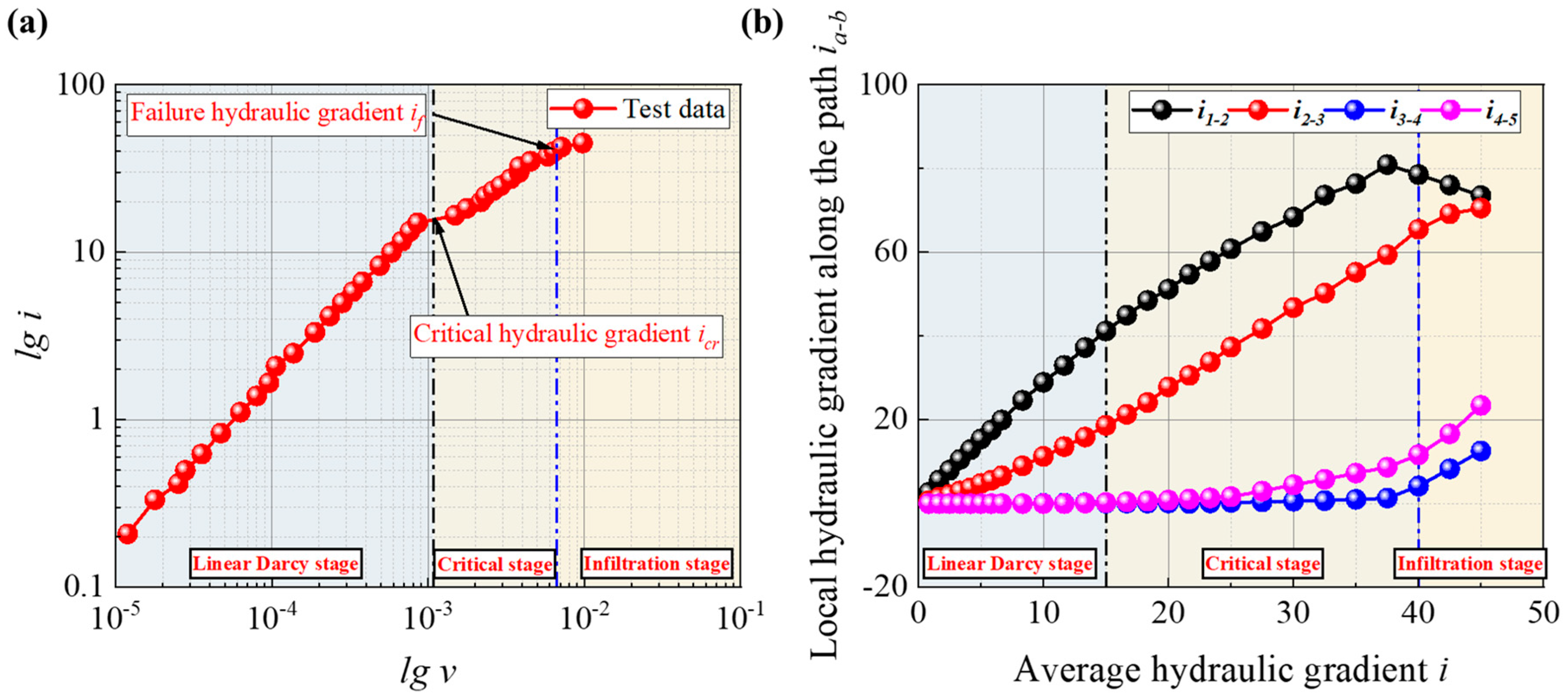


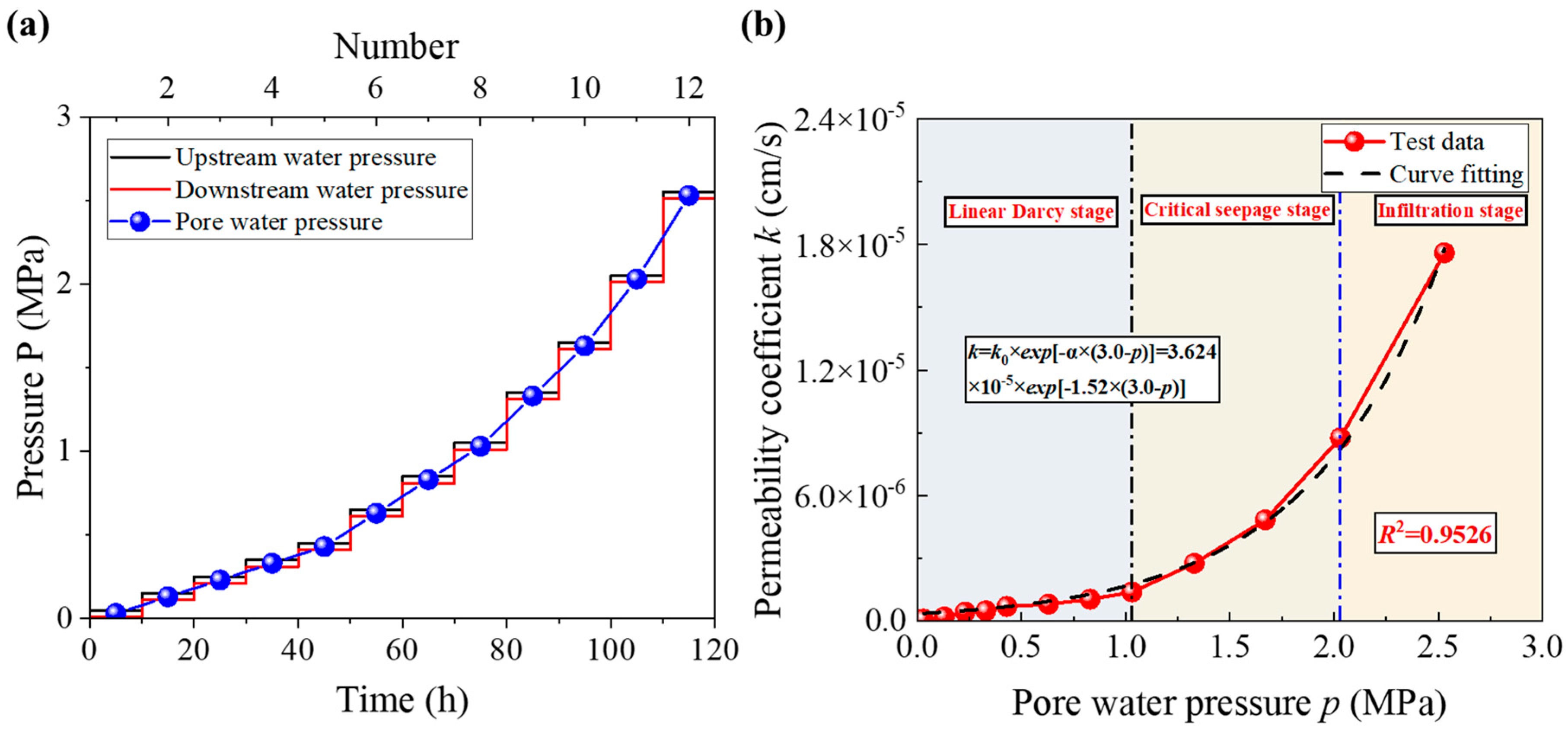




| Sample Type | Test Methods | Measuring Indicators | Model |
|---|---|---|---|
| In situ sample | Water pressure test | Permeability coefficient | / |
| In situ permeability test | Permeability parameters | Self-developed instruments | |
| XRD diffractogram analysis | Mineral composition, Content | TDM-20 desktop | |
| SEM-EDS | Spatial distribution of elements | Mira3 LMH | |
| NMR | Pore size distribution, Porosity | MesoMR12-040H-I | |
| Remolded sample | NMR | Pore size distribution, Porosity | MesoMR12-040H-I |
| Shear test | Cohesion, Internal friction angle | YSD-10a | |
| Uniaxial compression test | Uniaxial compressive strength | YSD-10a | |
| Triaxial test | Modulus of elasticity, Poisson | WDW-100 | |
| Indoor seepage test | Permeability parameters | / | |
| Seepage–stress coupling test | Permeability parameters | YSYH-3 |
| Number | 1 | 2 | 3 | 4 | 5 | Average |
|---|---|---|---|---|---|---|
| Cohesion c (MPa) | 0.42 | 0.45 | 0.43 | 0.47 | 0.49 | 0.45 |
| Internal friction angle | 34.75 | 32.48 | 31.73 | 32.96 | 30.52 | 32.49 |
| Uniaxial compressive strength σc (MPa) | 5.46 | 4.67 | 4.78 | 5.53 | 4.91 | 5.07 |
| Modulus of elasticity E (GPa) | 0.036 | 0.031 | 0.027 | / | / | 0.031 |
| Poisson ratio υ | 0.31 | 0.34 | 0.33 | / | / | 0.33 |
| Number | Drill 1 | Drill 2 | Drill 3 |
|---|---|---|---|
| Length (m) | 2.70 | 3.00 | 3.00 |
| Seepage (L/min) | 11.06 | 24.03 | 11.64 |
| Pressure (MPa) | 1.03 | 1.06 | 1.09 |
| P-Q curves | A (Laminar type) | B (Turbulent type) or E (Filling-type) | A (Laminar type) |
| Permeability (Lu) | 3.98 | 7.67 | 3.58 |
| Permeability coefficient (cm/s) | 3.79 × 10−5 | 7.51 × 10−5 | 3.50 × 10−5 |
| Test Type | Sample State | No. | Permeability Coefficient k (cm/s) | Critical Hydraulic Gradient icr | Failure Hydraulic Gradient if | Effective Stress Sensitivity Coefficient α |
|---|---|---|---|---|---|---|
| In-situ water pressure test | In situ | 1 | 3.79 × 10−5 | / | / | / |
| 2 | 7.51 × 10−5 | / | / | / | ||
| 3 | 3.50 × 10−5 | / | / | / | ||
| In situ testing | / | 5.74 × 10−5 | 15.0 | 40.0 | / | |
| Indoor routine test | Remolded | / | 5.58 × 10−6 | 20.82 | 78.88 | / |
| Seepage–stress coupling test | / | 1.03 × 10−7 | 1.52 |
| Parameters | Unit | F2 Fault | Experiment | |
|---|---|---|---|---|
| In Situ | Reshape | |||
| Dry density (ρ) | g/cm3 | 2.25 | 2.25 | Wax sealing method |
| Relative density (Dr) | / | / | 91.2% | Vibratory method |
| Porosity (n) | / | NMR method | ||
| Modulus of elasticity (E) | GPa | 0.03 | 0.031 | Triaxial compression method |
| Poisson ratio (υ) | / | 0.35 | 0.33 | |
| Uniaxial compressive strength (σc) | MPa | 5.0 | 5.07 | Uniaxial compression method |
| Cohesion (c) | MPa | 0.07 | 0.45 | Straight shear method |
| Internal friction angle (φ) | ° | 20.55 | 31.64 | |
| Type | Method | Porosity n (%) | |||
|---|---|---|---|---|---|
| Sample 1 | Sample 2 | Sample 3 | Average | ||
| In situ | NMR | 15.92 | 16.71 | / | 16.31 |
| Saturation weighing method | 15.98 | 16.87 | / | 16.42 | |
| Remolded | NMR | 16.58 | 16.94 | 16.70 | 16.74 |
| Saturation weighing method | 16.71 | 17.05 | 16.82 | 16.86 | |
Disclaimer/Publisher’s Note: The statements, opinions and data contained in all publications are solely those of the individual author(s) and contributor(s) and not of MDPI and/or the editor(s). MDPI and/or the editor(s) disclaim responsibility for any injury to people or property resulting from any ideas, methods, instructions or products referred to in the content. |
© 2025 by the authors. Licensee MDPI, Basel, Switzerland. This article is an open access article distributed under the terms and conditions of the Creative Commons Attribution (CC BY) license (https://creativecommons.org/licenses/by/4.0/).
Share and Cite
Zhao, Y.; Wang, H.; Qiao, S.; Li, Z.; Sheng, J. Multi-Scale Mechanisms for Permeability Evolution in Remolded Fault Gouge: From Mineral-Particle Migration to Pore Structure. Water 2025, 17, 3307. https://doi.org/10.3390/w17223307
Zhao Y, Wang H, Qiao S, Li Z, Sheng J. Multi-Scale Mechanisms for Permeability Evolution in Remolded Fault Gouge: From Mineral-Particle Migration to Pore Structure. Water. 2025; 17(22):3307. https://doi.org/10.3390/w17223307
Chicago/Turabian StyleZhao, Yuanyang, Huimin Wang, Shaobo Qiao, Zhihan Li, and Jinchang Sheng. 2025. "Multi-Scale Mechanisms for Permeability Evolution in Remolded Fault Gouge: From Mineral-Particle Migration to Pore Structure" Water 17, no. 22: 3307. https://doi.org/10.3390/w17223307
APA StyleZhao, Y., Wang, H., Qiao, S., Li, Z., & Sheng, J. (2025). Multi-Scale Mechanisms for Permeability Evolution in Remolded Fault Gouge: From Mineral-Particle Migration to Pore Structure. Water, 17(22), 3307. https://doi.org/10.3390/w17223307






